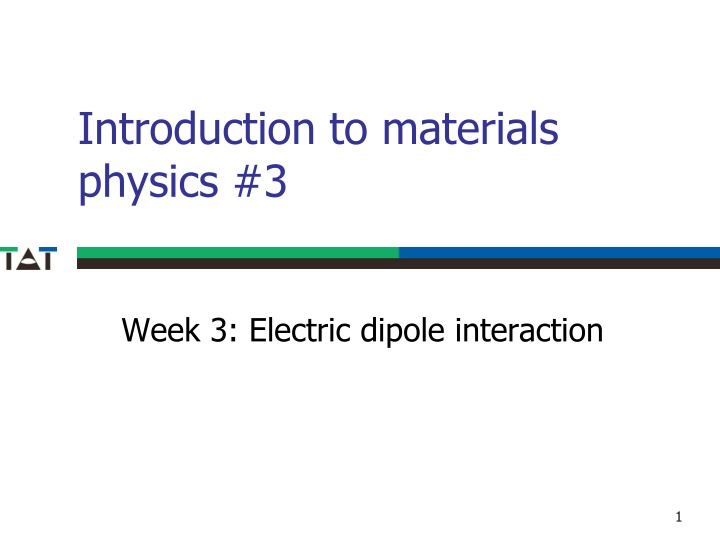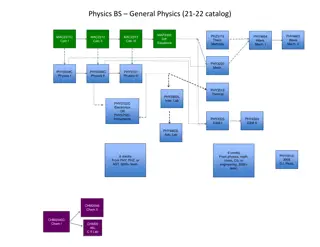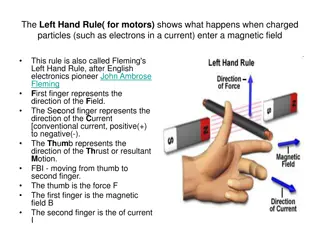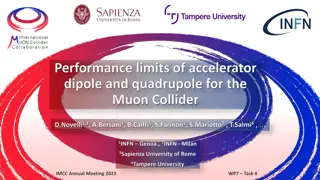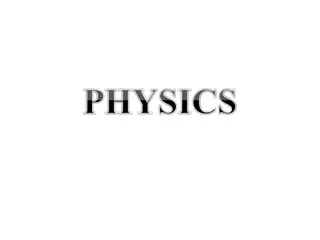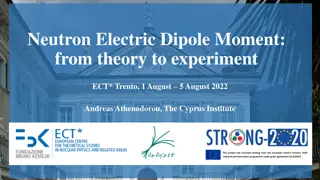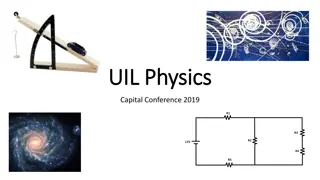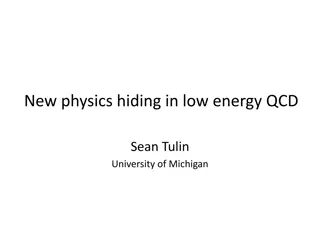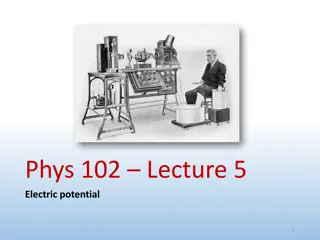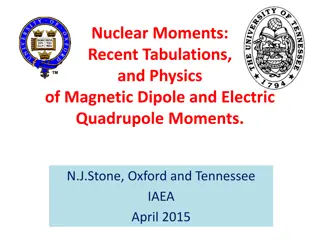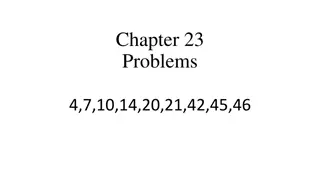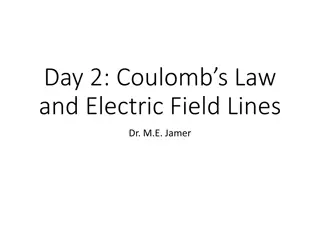Electric Dipole Interaction in Materials Physics
Dive into the world of electric dipole interaction in materials physics, exploring topics such as electromagnetic wave properties, force acting on electric dipoles, potential energy calculations, and the representation of waves through phasors. Learn about the differences between electromagnetic wave propagation in vacuum versus dielectric materials, refractive indices, and the measurement of electric properties in materials. Discover the intricacies of electric dipole moments, polarization, and potential energy calculations within an electric field.
Download Presentation

Please find below an Image/Link to download the presentation.
The content on the website is provided AS IS for your information and personal use only. It may not be sold, licensed, or shared on other websites without obtaining consent from the author.If you encounter any issues during the download, it is possible that the publisher has removed the file from their server.
You are allowed to download the files provided on this website for personal or commercial use, subject to the condition that they are used lawfully. All files are the property of their respective owners.
The content on the website is provided AS IS for your information and personal use only. It may not be sold, licensed, or shared on other websites without obtaining consent from the author.
E N D
Presentation Transcript
Introduction to materials physics #3 Week 3: Electric dipole interaction 1
Chap. 1-2: Table of contents Review of electromagnetic wave Electric dipole interaction Force acting on electric dipole Potential energy of electric dipole in electric field Mechanical oscillator model of electric dipole Lorentz model and refraction index Absorption and dispersion of light in material Absorption and refraction 2
1. Review of electromagnetic wave: Electromagnetic waves in vacuum VS. dielectric material In vacuum: 0, 0 ( ) ( ) ( ) 0 / / 1 = k c 2.99792458 / 1 0 0 = = c = k + z , cos Ex t z E kz t 0 0 = + cos / E t 0 0 0 8 10 (speed m/s of light in vacuum) ) / cos , 0 t z k E z t Ex = In dielectric material: ( 0), 0 ( ) ( / ' / 1 k c = + 0 0 / 1 c ( n ) / 1 = = = 0 0 ' c Speed of material in light 0 n / : refractive index 3 0
Electromagnetic wave in dielectric material Electromagnetic wave in dielectric material propagates with slower speed c than that in vacuum c. n n c c = = , / 0 0 = ' / , refractive : index ( ) + 1 n ' , 1 n c c Measurement of n provides (or ), which describes the electric property of a material. (Optical measurement) 4
Phasor representation Waves can be represented by complex exponential function instead of real trigonometric function. Real trigonometric function ( ) ( , + = t kz E z t Ex ) 0cos 0 Complex exponential function (Phasor rep.) ( ) ( ) ( ) ( ) ( ) complex : exp 0 0 0 i E E = ~ E ~ E = , exp i t z kz t 0 x EXERCISE: 1 ~ E ~ E ~ E ( ) ( ) = = + * x , Re , , , E t z t z t z t z x x x 2 ~ amplitude NOTE: ~ denotes phasor representation, and therefore it is complex. 5
2. Electric dipole interaction: Force and potential energy Force acting on charge and potential energy of electric dipole moment Force acting on charge F Q = E Electric dipole moment and Polarization Q p P = = p d Electric dipole moment Q Electric polarization e x Sd S Potential energy ( E ) ( E ) ( p ) = + + U Q Ex Q E x d 0 0 ( ) = = Qd 6
Electric dipole moment Electric dipole moment is a pair of two positive and negative charges with the same magnitude separated with the displacement vector r. p r Q 7
Electric polarization and electric dipole moment of atoms (or molecules) Electric polarization consists of electric dipole moments of atoms. To know electric dipole moment of a single atom is equivalent to know electric polarization 8
Relation between electric dipole moment of atom and electric polarization = = p p p total : electric dipole moment N n V a a a p V = = P p P p relation : between and n a a a 9
3. Mechanical oscillator model of electric dipole: Electric dipole moment of an atom induced by external electric field An atom consists of a positively charged nucleus and negatively charged electron cloud. If external electric field exists, the nucleus and the center of the electron cloud are displaced. electric dipole moment Without E field With E field = p R Q a 10
Electric dipole moment as an mechanical oscillator: Lorentz model Electric dipole moment of an atom can be regard as a mechanical oscillator. Stronger electric field displaces the electron cloud farther. Spring Inertia of the electron cloud Mass 11
Oscillatory motion of electron cloud Motion of the center of the electron cloud Damped harmonic oscillation Equation of motion d 2 2 d ( ) t + + = QE 2 cos M R M R KR 0 d d t t Set z=0, 0=0 for simplification Phasor representation ~ d = 2 d d ~ ~ ~ ( ) + + = 2 exp i M R M R K R Q E t 0 2 d t Re t ( ) R ~ R 12
Solution of damped oscillation Equation of motion (phasor rep.) 2 d d ~ ~ ~ ~ ( ) t + + = i 2 exp M R M R K R Q E 0 2 d d t t EXERCISE: Solve the above differential equation. Solution (phasor rep.) / Q M + ~ R ~ R ~ E ( ) t ( ) ( ) = = exp i exp i t t 0 0 2 2 0 i 2 / Q M + ~ R ~ E = 0 0 2 2 0 i 2 13
Electric dipole moment of an atom, polarization, susceptibility and permittivity Electric dipole moment of an atom (Phasor) ( ) ( ) t R Q t p 2 / + Q M i 2 ~ ~ ( ) t ~ = i = i exp exp E a 0 0 2 2 0 Electric polarization (Phasor) ( ) Q n i 2 0 + ~ ~ ~ ~ = = P E t n / p 0 a a 2 2 / M n Q 2 0 M i 2 + ~ ~ ( ) ( ) t = = a a exp i E t E 0 2 2 2 Electric susceptibility and permittivity (Phasor) ( ) + i 2 2 a 0 0 2 / n Q M ~ = a 0 2 2 0 ( ) / 2 0 n Q M ( ) ~ ~ = + = 0 1 1 + 2 i 2 14
Refraction index and electric susceptibility Relation between refraction index and electric susceptibility / 0 n + = = + = + = : ' 1 " ' n the n n ~ ~ n = ~ ~ ~ ~ n 2 / 1 complex. be must 0 ~ ~ n Let ' i , " 2 n ' i " n n = + imaginary : " 2 real part n = 2 ' " part EXERCISE: Derive the above relation between n , n and , . 15
Real and imaginary parts of n and Electric susceptibility ( 0) ( ) 2 0 i 2 + 2 / n Q M ~ = + = a 0 ' i " 2 ( ) 2 ( ) S + 2 0 2 0 2 / 2 S = 0 0 Real part : ' ( ) 2 0 ( ) 2 2 2 2 2 0 2 4 0 S + S 2 2 / 2 + n Q = = 0 a Imaginary part : " where , S ( ) ( ) 2 2 2 0 2 M 2 2 0 2 2 4 0 0 Refractive index (n 1, n 1) ( ) S + + / 4 1 + = + 0 0 0 Real part : ' 1 1 n ( S ) 4 + ( ) 2 2 2 2 4 MV 0 0 0 / 0 1 = 0 Imaginary part : " n ( ) ( ) 2 2 + 2 2 4 MV 0 0 0 0 16
Graph of refractive index Refractive index (non-dimensional) n : real part n : imaginary part Angular frequency (rad/s) 17
4. Absorption and dispersion of light in material What are the real and imaginary parts of refractive index? Electric field (phasor rep.) ( ) ( ) / i exp , 0 = z k E z t Ex ~ n ~ ~ ~ E = exp i t z t 0 c Replace n by n +in ( ) = E z t Ex , + c ' ' i " n n ~ ~ i exp z t 0 " n n ~ = i exp exp E z t z 0 c c Propagating wave n traditional Spatial damping n absorption 18 refractive index
Absorption of light Absorption: n describes damping of wave by dielectric. Vacuum Vacuum Dielectric Damping of electric field during D D n " exp D c Damping of light intensity I ( E2) 2 " c n ( ) = exp exp D AD D = exp d opt 2 " c n Absorption : coefficien t A 1 A c = Optical : depth d opt 2 " n 19
Dispersion: separation of colors n is a function of . Refraction is different among colors. In most cases, 0 . n ( blue)>n ( red) Blue ray bends more deeply that red ray does. Snell' n law s : = sin n sin n 1 1 2 2 refracttiv : index e of dielectric 1, 2 2 , 1 angles : 1,2 of incidence refraction and dielectric in ( ' When n 1, ( 2 ) ) n ' , . blue red b r EXERCISE: Prove the above inequality. 20
How does one probe property of atoms from optical measurement? Mutual relation among optical, electric and atomic properties Optical property Refractive index n : Refraction n : Absorption Electric property (Dielectricity) Electric susceptibility : Real part : Imaginary part Atomic property Electric dipole moment of atom 0: Resonance frequency : Damping constant n = + 2 2 ' n " = 1 ' n n ( ) S / 2 0 S 0 ' 2 ' " " ( ) 2 + 2 0 / 2 + 0 " ( ) 2 2 0 21
Summary Review of electromagnetic wave Electric dipole interaction Force acting on electric dipole Potential energy of electric dipole in electric field Mechanical oscillator model of electric dipole Lorentz model and refraction index Absorption and dispersion of light in material Absorption and refraction 22
